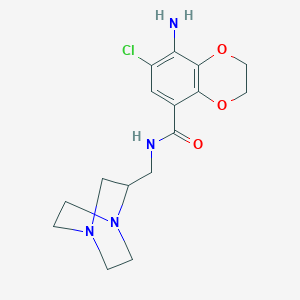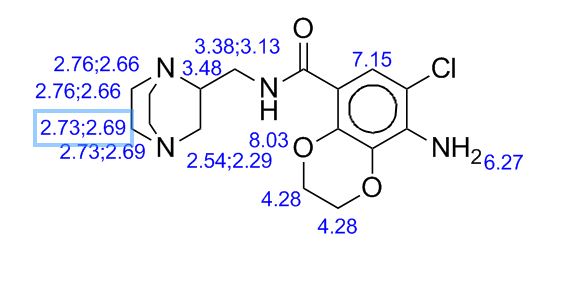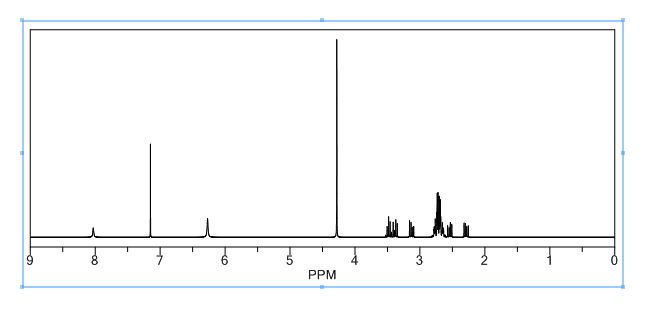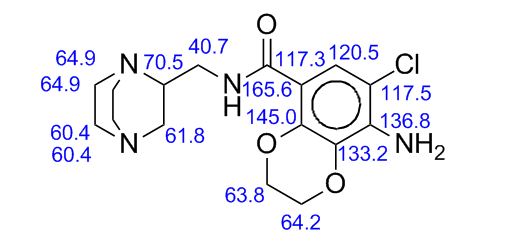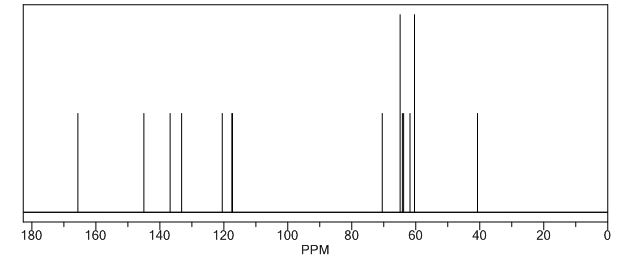CAS 186348-69-6
1,4-Benzodioxin-5-carboxamide, 8-amino-7-chloro-N-(1,4-diazabicyclo[2.2.2]oct-2-ylmethyl)-2,3-dihydro-, (-)-
- MW, 352.82, C16 H21 Cl N4 O3
-
US5663173 (A) – N-[(1,4-diazabicyclo[2.2.2] oct- 2-yl)methyl] benzamide derivatives, their preparations and their application in therapeutics
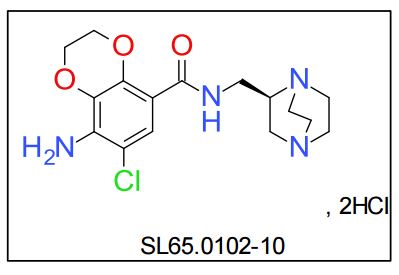
SL65.0102-10
(-)-1,4-benzodioxin-5-carboxamide-8-amino-7-chloro-N-(1,4-diazabicyclo[2.2.2]oct-2- ylmethyl)-2,3-dihydro-, hydrochloride
CAS 186348-31-2, C16 H21 Cl N4 O3 . 2 Cl H
Melting point: 220 ° C. (decomposition). EP0748807
[α] ![]() = -16.9 ° (c = 1, H 2 O).
= -16.9 ° (c = 1, H 2 O).
[α]D = -17.9 (C = 0.75, DMSO, t = 23°C) at 589 nm. DOI: 10.1021/acs.oprd.6b00262
5-HT3 and 5-HT4 inhibitor that was potentially useful for the treatment of neurological disorders.
Innovators-sanofi

Hoechst Marion Roussel (Sanofi) my organisation 1993-1997 Process development at Mulund, Mumbai, India.
CENTRE IS DR RALPH STAPEL, HEAD PROCESS DEVELOPMENT, SANOFI
The 5-HT4 receptor is a G-protein coupled receptor (GPCR) which belongs to the serotonin receptor family. The role of the 5-HT4 receptor in the modulation of many diseases is well described in the literature.(1)
During the last decades, an impressive body of evidence suggested that selective stimulation of neuronal 5-HT4 receptor subtypes could be beneficial in the symptomatic treatment of memory disorders, including many antidepressants, antipsychotics, anorectics, antiemetics, gastroprokinetic agents, antimigraine agents, hallucinogens, and antactogens.(2)
Within effort to discover treatments of memory dysfunction, SL65.0102-10, a selective 5-HT4 partial agonist (Ki 6.6 μM), was discovered as promising agent for the treatment of cognition impairment. Serotonin receptors are the target of a variety of pharmaceutical drugs; SL65.0102-10 emerged as a promising 5-HT3 and 5-HT4 inhibitor that was potentially useful for the treatment of neurological disorders.(3)

Samir Jegham
Lead Generation Senior Advisor for Asia Pacific Research Hub at Sanofi
“DRUG APPROVALS INT” CATERS TO EDUCATION GLOBALLY, No commercial exploits are done or advertisements added by me. This article is a compilation for educational purposes only.
P.S. : The views expressed are my personal and in no-way suggest the views of the professional body or the company that I represent
SYNTHESIS
SL65.0102-10
CONTD…………..
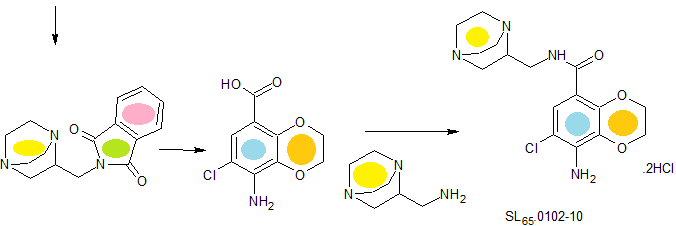
Synthesis
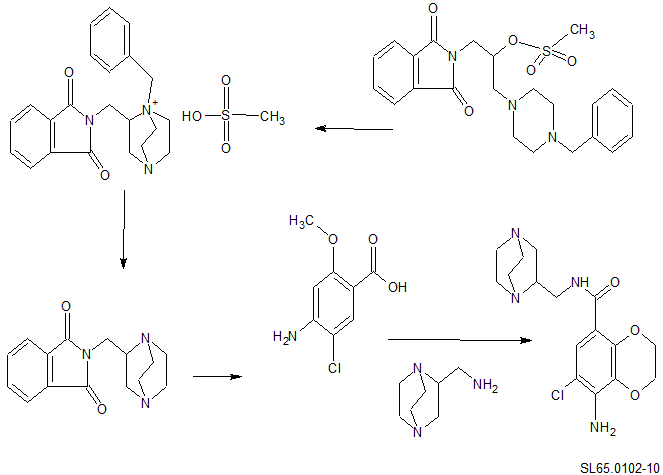
PATENT
(EP0748807) Derivatives of N- (1,4-diazabicyclo (2.2.2) -oct-2-yl) methyl benzamide, their preparation and their therapeutic use


Example 5 (Compound No. 9)
Ethyl (-) – 8-Amino-7-chloro- N – [(1,4-diazabicyclo [2.2.2] oct-2-yl) methyl] -2,3-dihydro-1,4 Benzodioxin-5-carboxamide.
5.1. (+) – (2,2-dimethyl-1,3-dioxolan-4-yl) methyl methanesulfonate.
The procedure described in Example 4.1, but from (+) – 2,2-dimethyl-1,3-dioxolane-4-methanol.
5.2. (-) – 2 – [(2,2-Dimethyl-1,3-dioxolan-4-yl) methyl] -1 H -isoindole-1,3 (2 H ) -dione.
The procedure described in Example 4.2, from methane sulfonate (+) – (2,2-dimethyl-1,3-dioxolan-4-yl) methyl.
Melting point: 81.2-81.3 ° C.
[α]![]() = -34.9 ° (c = 1, CH 2 Cl 2 ).
= -34.9 ° (c = 1, CH 2 Cl 2 ).
5.3. (-) – 2- (2,3-dihydroxypropyl) -1 H -isoindole-1,3 (2 H ) -dione.
The procedure described in Example 4.3, from (-) – 2 – [(2,2-dimethyl-1,3-dioxolan-4-yl) methyl] -1 H -isoindole-1, 3 (2 H ) -dione.
Melting point: 122.8-122.9 ° C.
[α]![]() = -48.8 ° (c = 1, CH 3 OH).
= -48.8 ° (c = 1, CH 3 OH).
5.4. (-) – 2 – [(2-Phenyl-1,3-dioxolan-4-yl) methyl] -1 H -isoindole-1,3 (2 H ) -dione.
The procedure described in Example 4.4, from (-) – 2- (2,3-dihydroxypropyl) -1 H -isoindole-1,3 (2 H ) -dione.
Melting point: 84 ° C.
[α]![]() = -59 ° (c = 1, CH 2 Cl 2 ).
= -59 ° (c = 1, CH 2 Cl 2 ).
5.5. Benzoate (-) – 2-bromomethyl-1- (1,3-dihydro-1,3-dioxo-2 H -isoindol-2-yl) ethyl.
The procedure described in Example 4.5, from (-) – 2 – [(2-phenyl-1,3-dioxolan-4-yl) methyl] -1 H -isoindole-1,3 ( 2 H ) -dione.
Melting point: 118.4-118.6 ° C.
[α]![]() = -58.2 ° (c = 1, CH 2 Cl 2 ).
= -58.2 ° (c = 1, CH 2 Cl 2 ).
5.6. (+) – 2- (oxiranylmethyl) -1 H -isoindole-1,3 (2 H ) -dione. Fusion point :
The procedure described in Example 4.6, from benzoate (-) – 2-bromomethyl-1- (1,3-dihydro-1,3-dioxo-2 H -isoindol-2-yl) ethyl.
Melting point: 100.4-100.5 ° C.
[α]![]() = + 45.5 ° (c = 1, CHCl 3 ).
= + 45.5 ° (c = 1, CHCl 3 ).
5.7. Dihydrochloride (-) – 8-Amino-7-chloro- N – [(1,4-diazabicyclo [2.2.2] oct-2-yl) methyl] -2,3-dihydro-1,4-benzodioxin-5 -carboxamide.
The procedure described in Example 4.7, from (+) – 2- (oxiranylmethyl) -1 H -isoindole-1,3 (2 H ) -dione.
Melting point: 220 ° C. (decomposition).
[α] ![]() = -16.9 ° (c = 1, H 2 O).
= -16.9 ° (c = 1, H 2 O).
Paper
The process development and improvements for route selection, adapted to large scale for the pilot-scale preparation of SL65.0102-10, an N-diazabicyclo[2.2.2]-octylmethyl benzamide, a 5-HT3and 5-HT4 receptor active ligand for the treatment of neurological disorders such as cognition impairment, are described in this article. Notable steps and enhancements are compared to the original route, including the improvement of a chiral epoxide synthesis by shortening the number of chemical steps, the deprotection of a quaternary ammonium salt, and the redesign of the final amidification coupling to avoid chromatography.
Pilot Scale Process Development of SL65.0102-10, an N-Diazabicyclo[2.2.2]-octylmethyl Benzamide
(-)-1,4-benzodioxin-5-carboxamide-8-amino-7-chloro-N-(1,4-diazabicyclo[2.2.2]oct-2- ylmethyl)-2,3-dihydro-, hydrochloride (1:2), SL65.0102-10 (1).
……………….. to provide compound 1 (10.3 kg, 76.7%). Compound 1 could be recrystallized in acetone/water (12/2 volumes).
1H-NMR (DMSO-d6, 500 MHz), δ ppm: 3.38 (dd, 1H, J = 12.0 , 6.0 Hz), 3.60-3.45 (m, 7H), 3.65 (t, 1H, J =10.0 Hz), 3.72 (dt, 1H, J =6.0 , 14.0 Hz), 3.83 (m, 2H), 4.01 (m, 1H), 4.33 (m, 2H), 4.39 (m, 2H), 7.37 (s, 1H), 8.35 (t, 1H, J =6.0 Hz). Only 19 protons are observed on 1H spectrum instead of 21 expected. The two amino protons of the molecule are not visible because of chemical exchange with residual water of DMSO-d6 solvent.
13C NMR (DMSO-d6, 125 MHz): δ 38.4, 39.0, 42.8, 43.4, 45.4, 46.5, 54.4, 64.1, 65.1, 109.3, 110.0, 123.2, 130.5, 138.1, 141.8, 165.0.
HRMS: exact mass (by Xevo QToF), MH+ found: 353.1374 (MH+ calculated: 353.1380, difference: -1.7 ppm).
[α]D = -17.9 (C = 0.75, DMSO, t = 23°C) at 589 nm.
Elementary analysis: found C 43.0660%, H 5.5150%, N 12.4792%, calculated C 43.31%, H 5.68%, N 12.63%
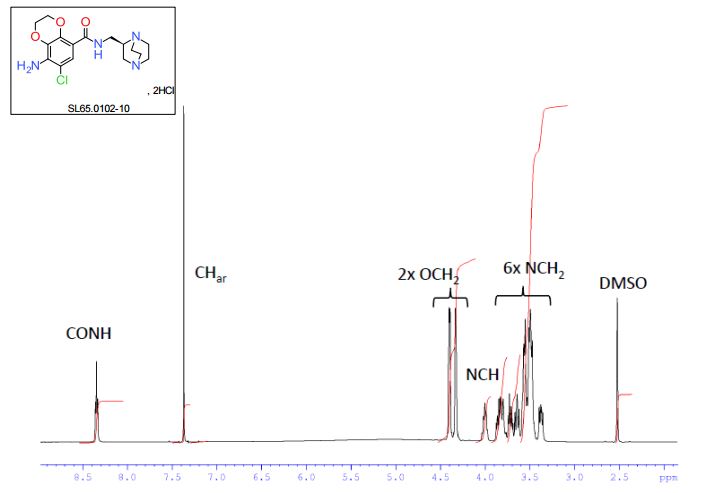
1H AND 13C NMR PREDICT
References
-
(a) Hoyer, D.; Clarke, D. E.; Fozard, J. R.; Hartig, P. R.; Martin, G. R.; Mylecharane, E. J.; Saxena, P. R.;Humphrey, P. P. Pharmacol. Rev. 1994, 46 ( 2) 157– 203
(b) Frazer, A.; Hensler, J. G.Chapter 13: Serotonin Receptors. In Siegel, G. J.; Agranoff, B. W.; Albers, R. W.; Fisher, S. K.; Uhler, M. D., Eds.; Basic Neurochemistry: Molecular, Cellular, and Medical Aspects; Lippincott-Raven, Philadelphia,1999; pp 263– 292.
-
Frick, W.; Glombik, H.; Kramer, W.; Heuer, H.; Brummerhop, H.; Plettenburg, O. Novel fluoroglycoside heterocyclic derivatives, pharmaceutical products containing said compounds and the use thereof.
(a) WO2004/052903, 2004.
(b) WO2004/052902, 2004.
-
Jegham, S.; Koenig, J. J.; Lochead, A.; Nedelec, A.; Guminski, Y.N-[(1,4-diazabicyclo[2.2.2]oct-2-yl)methyl] benzamide derivatives, their preparations and their application in therapeutics.
(a) FR 2756563 06/13/1995 9506951, 1995.
(b) US 5663173, 1997; Washington, DC: U.S. Patent and Trademark Office.
“DRUG APPROVALS INT” CATERS TO EDUCATION GLOBALLY, No commercial exploits are done or advertisements added by me. This article is a compilation for educational purposes only.
P.S. : The views expressed are my personal and in no-way suggest the views of the professional body or the company that I represent
////////SL65.0102-10, SANOFI, 5-HT3 , 5-HT4 inhibitor, neurological disorders
O=C(NCC2CN1CCN2CC1)c4cc(Cl)c(N)c3OCCOc34

















